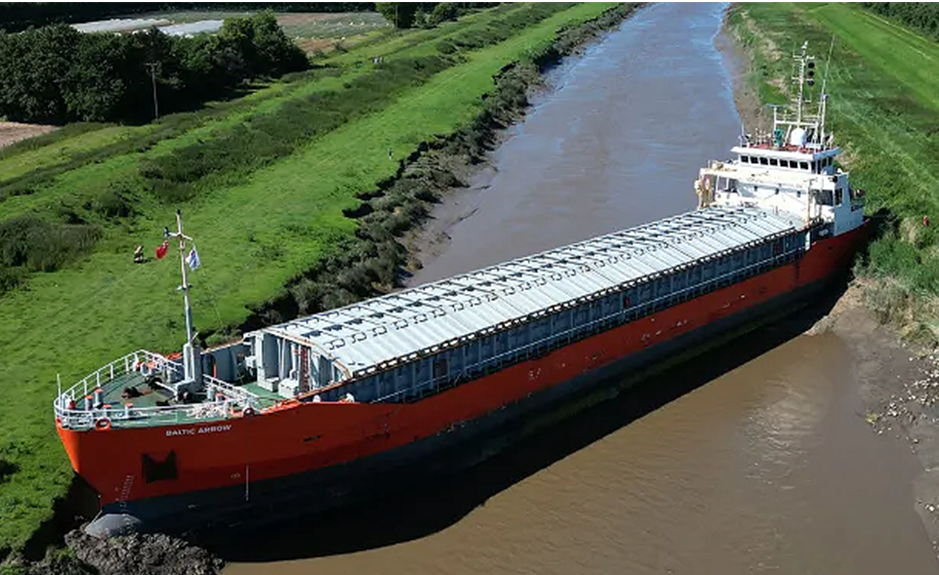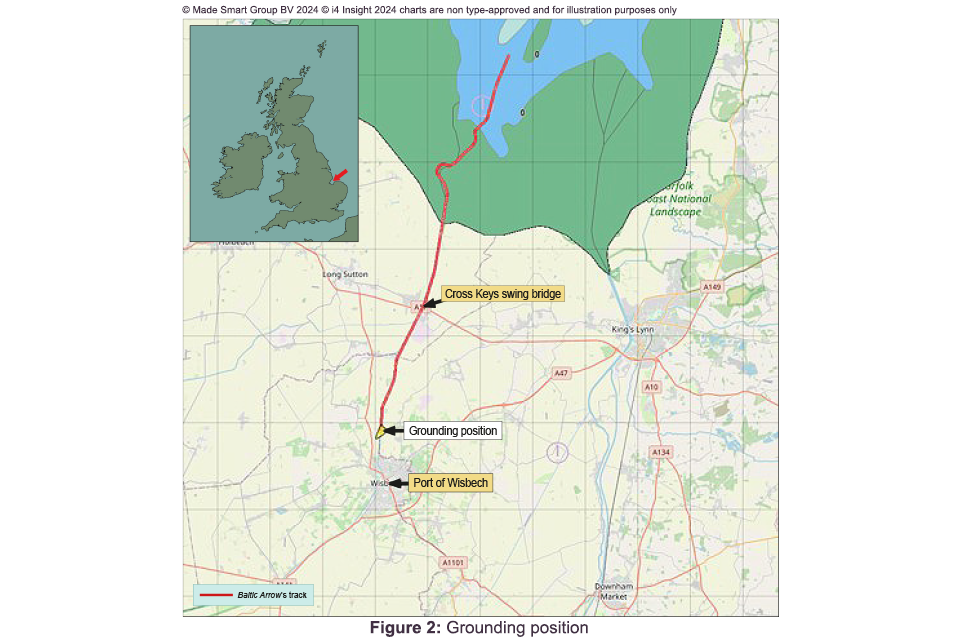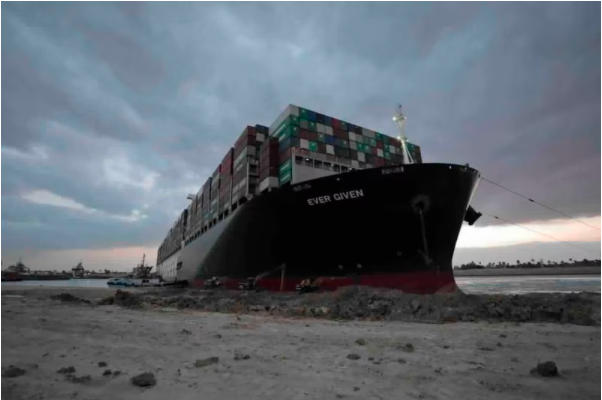|
In June this year, a bulk carrier got stuck in the middle of the river on its way to the port of Visbeech. This matter has caused heated discussions because of the "god-like" Suez Canal blockage in 2021. Recently, the United Kingdom Maritime Accident Investigation Service (MAIB) published the results of its investigation into the accident. Surprisingly, even the cause of the incident is similar to the accident three years ago.
01 Incident reports are issued
At around 9 a.m. on June 25, 2024, the cargo ship "Baltic Arrow" was stranded on its way to the port of Visbich due to the narrowing of the inland waterway, and the hull of the ship was stuck in the middle of the river. Recently, the United Kingdom Maritime Accident Investigation Service (MAIB) published the results of its investigation into the accident.
Accident review
According to MarineTraffic, a global authority on ship tracking, the ship was scheduled to depart from Brunsbuettel, Germany, to the east of England. In this case, the captain of the 80-meter-long ship reported a "grounding", and the relevant video footage showed the ship staying in the river in an oblique shape.
It is reported that the cargo ship flew the flag of St. Kitts and Nevis and had six crew members and two local pilots on board. No casualties or property damage were reported.

According to the report provided by the MAIB, the day before the grounding, the "Baltic Arrow" dropped anchor at the Wisbech anchorage on the east coast of England.
At 5:40 a.m. the next morning, the Baltic Arrow set off for the pilot station, from which two pilots boarded.
After a brief exchange between the captain and the two pilots, the senior pilot (Pilot B) evaluated the voyage and said that the pilot A was at the helm. The captain and pilot B also remained in the wheelhouse, but they were not responsible for any other than monitoring the channel.
Subsequently, while passing the cross-key swing bridge, Pilot A reduced the speed of the ship in preparation for the berthing operation. Half an hour later, Pilot A noticed that the boat was slightly deflected to the left of the planned fairway. Therefore, Pilot A hit the 30 ° right rudder and started the main engine forward to correct the position of the ship in the narrow fairway.

According to the MAIB report, the ship may have been affected by the quay wall effect, which the pilots tried to counteract by playing the right rudder and starting the main engine forward.
Shore wall effect
The quay wall effect refers to the phenomenon that when the ship sails along the shore wall, the hydrodynamic force on the two sides of the hull is different due to the distance between the hull and the shore wall, and causes the ship as a whole to close to the shore wall, and the bow of the ship is reversed to the shore wall.
In order to avoid the quay wall effect, the pilot should try to drive in the center of the channel after entering the narrow channel, which can minimize the uneven flow caused by the quay wall effect. And reduce the speed appropriately. In order to further offset the lateral force caused by the shore wall effect, the pilot can increase the speed of the ship's propeller and reduce the negative impact of the lateral force on the stability of the ship by controlling the rudder effect of the ship, improving its control and longitudinal control, and enhancing the steering angle, so as to effectively guarantee the driving safety of the ship in the narrow channel.
MAIB reported that under the operation of Pilot A, the course of the "Baltic Arrow" was overcorrected, and the head quickly turned to starboard. By the time Pilot A noticed that it was too late, the other members of the bridge had failed to take effective evasive action in time. Eventually, at the bow of the boat ran aground on the west bank of the river at a speed of 6 knots to the ground.
02 Analysis of the cause of the accident
According to the preliminary findings of the MAIB, at the time of the accident, Pilot A had been at the helm for almost two hours, which may have led to a lack of concentration on the part of the pilot.
Narrow waterway is a common type of water area in ship pilotage, and it is also a high-risk shipping area, which is commonly found in rivers, ports and other places, and has the characteristics of narrow, curved and high traffic density. Through such a channel, not only does the pilot need to have high maneuvering skills and rich pilotage experience, but also the pilot needs to have a high degree of concentration.
On the other hand, the other members of the ship's wheelhouse, who were also in the wheelhouse, also failed to do their part. The MAIB report revealed inefficient communication among the ship's wheelhouse team and a lack of a common mental model of the task being performed. As a result, no one was able to detect the development of events in time to prevent the stranding from happening.
The bridge team is a group (including the captain, pilot, sailor and other related personnel), and the pilot should make full use of the bridge resources, especially to maintain a regular lookout and use a safe speed. According to the requirements of bridge resource management, the pilot captain and other bridge personnel perform their duties according to the requirements to form a bridge resource management with a wide range of attention, sensitive and efficient, effective and complete information communication, and complementary and orderly work.
03 Similar causes produce the same fruit
When the news of the accident was published in the foreign media, there was a lot of discussion on the grounds that the accident was too much like a miniature version of the Suez Canal blockage that happened in 2021. The massive container ship "Ever Given" was blocked in the vital waterway for nearly a week, causing billions of dollars in global trade to suffer.
Last July, the Panama Maritime Authority released a final 68-page investigation report whose findings were also related to pilots.
Report review:
According to the report of the Panama Maritime Authority, at 5:48 a.m. on March 23, 2021, the first pilot Yu boarded the ship to activate the escort and lead the container ship into the Suez Canal. The first pilot stayed on board for about 1 hour and 40 minutes before handing it over to the other two pilots for crossing.
Around 7:20 a.m., winds increased dramatically, with gusts of up to 40 mph, and windswept sand greatly reduced visibility. The captain and pilots had difficulty maintaining the position of the Ever Given in the center of the channel, and the pilots ordered the speed to be increased to 12 knots, while the Suez Canal had a specified maximum speed of 8.64 knots. But the Panama Maritime Authority pointed out that speeding is not uncommon when passing through the Suez Canal.

During the process, one pilot gives formal orders, while another provides advice and monitors the navigation. According to the Suez Canal rules, it is up to the pilot to advise the ship, while the captain remains in command. The Panama Maritime Authority noted that the captain of the Ever Given intervened at least twice in an attempt to change the pilot's orders regarding the position of the rudder. The Panama Maritime Authority said the pilot ordered the rudder to shift from port to starboard, never let the ship go back to the center, and did not give the helmsman a driving route.
The Panama Maritime Authority, through analysis of voice data records, reported that the pilots had been conversing in Arabic despite the fact that 25 India crew members, including the captain, did not speak Arabic. They translated the Arabic from the recording and found the pilots arguing. From their conversation, it became known that around 7:37 a.m., the pilots seemed to be beginning to realize that they were unable to control the ship, which was in danger of running aground.
Eventually, the Ever Given ran aground, during which the captain tried to get the ship out of trouble, but to no avail.
The final investigation report of the Panama Maritime Authority on the grounding of the "Ever Given" noted that the vessel's traffic management system, pilots and captains did not properly assess the adverse weather conditions, especially strong winds and reduced visibility, suggesting that the vessel should seek the help of a tugboat when sailing north.
On the other hand, the report argues that the language barrier is one of the key issues affecting communication between crew and pilots, and these should be taken into account. In the case of the Ever Given, although the pilot's orders were given in English, discussions between them were always in Arabic, so the bridge team could not understand the pilot's concerns as well as the potential danger.
04 Reflection on the accident
Two similar grounding accidents were related to communication and cooperation between the pilot and the crew on the bridge.
Globally, the vast majority of ports are pilotage. However, due to the differences in the pilot's skills and the cultural differences between different regions, the communication between the captain and the pilot is often not smooth. This kind of communication barrier frequently leads to safety accidents such as ship grounding and collision during the pilot's ship, which brings a lot of hidden dangers to maritime traffic.
A relationship of mutual cooperation and mutual supervision should be established between the captain and the pilot. The captain needs to have a thorough understanding of the basic condition of the crew, the maneuverability of the ship, and an in-depth understanding of the operation status and limitations of the ship's key equipment; The pilot needs to be proficient in the hydrological characteristics of the port channel, the operation law of the ship flow, proficient in the navigation rules and customary navigation methods in and out of the port, and have excellent language communication skills.
As the supreme commander of the ship, the crew and the work on board must be carried out under his command, including the pilotage, which must be carried out with the help of the captain's functions. As the key core figures in the work of entering and leaving the port, it is necessary for the captain and the pilot to supervise each other. Therefore, the captain has a supervisory role and monitoring requirements in the pilot's work, and corrects the pilot's erroneous instructions in a timely manner for any negligence or negligence of the pilot, and the captain can refuse the pilot's orders and instructions if necessary, and make self-adjustment and correction to ensure the absolute safety of the ship.
According to China's "Pilotage Management Regulations", the master shall provide work convenience for the pilots and cooperate with the pilots to carry out pilotage; To answer the pilot's questions about pilotage, the pilot's pilotage instructions shall be adopted except in cases that endanger the safety of the ship; After the pilot board the ship, he shall introduce the pilotage plan to the captain of the pilot ship; The master of the piloted ship shall introduce to the pilot the maneuverability of the ship and other information related to the pilotage business.
Therefore, the communication between the pilots after boarding the ship is very important, the two complement each other's advantages, match and cooperate, unite and help each other, and tacit cooperation, when entering and leaving the port, the ship will become safer and smoother in handling, command, external communication, and internal coordination.
https://www.cnss.com.cn/html/currentevents/20240929/354696.html
|